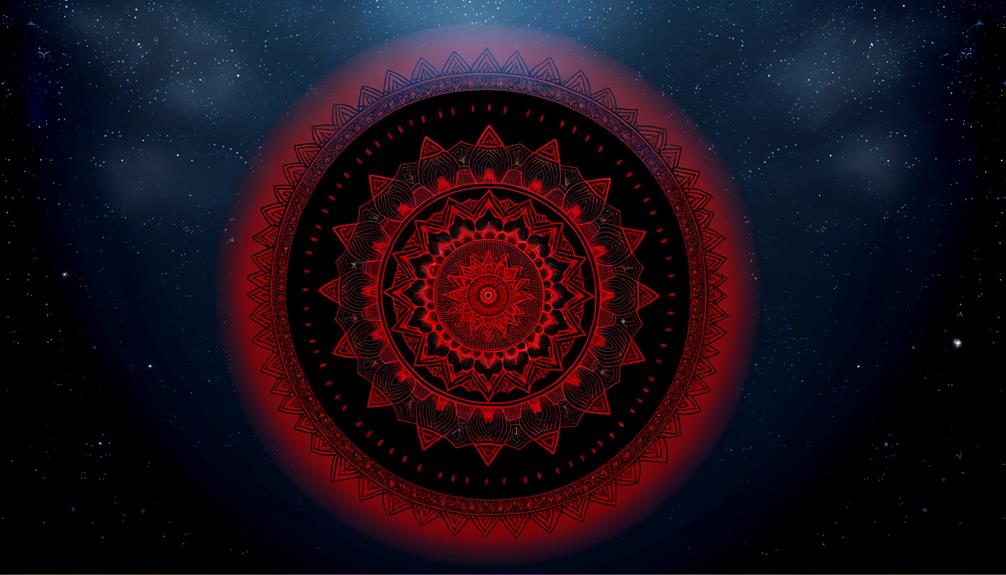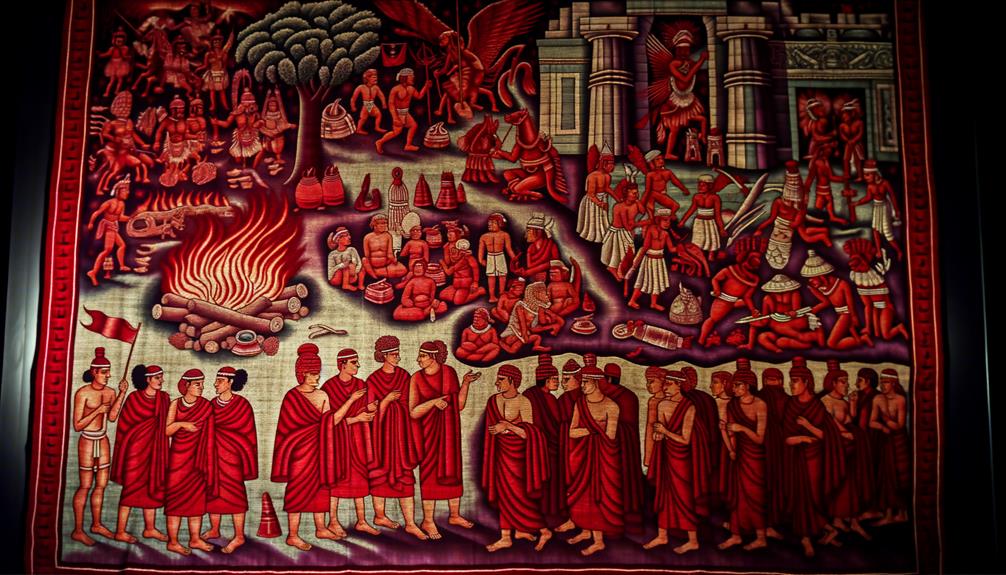Spiritual Meaning of Red and Black: Power and Duality
The spiritual meanings of red and black are deeply interwoven with cultural and historical significance. Red symbolizes energy, passion, and protection, often associated with the root chakra and primal energy.
It is prominent in rituals to invoke courage and connect with the material and spiritual domains. Black, conversely, represents mystery, transformation, and introspection, acting as a metaphor for the unconscious and potential rebirth.
Together, these colors create a dynamic interplay, balancing action with contemplation, and imbuing spiritual practices with both vivacity and depth. The interplay embodies the eternal dance between opposing yet complementary forces, enriching spiritual traditions.

Spiritual Meaning of Red and Black: Duality, Power, and Spiritual Awakening
| Aspect | Spiritual Insight |
|---|---|
| Duality | Represents the balance between light and shadow, action and stillness |
| Power and Strength | Symbol of intense spiritual force and grounded energy |
| Passion and Mystery | Combines fiery desire (red) with deep inner knowing (black) |
| Transformation | Indicates profound shifts in consciousness or identity |
| Protection and Courage | Offers spiritual defense while encouraging bold, purposeful action |
Historical Significance of Red

Throughout history, the color red has been imbued with profound symbolic meanings, often representing power, passion, and sacrifice across various cultures and civilizations.
In ancient Egypt, red was associated with life and victory, prominently featured in the regalia of pharaohs. Similarly, in China, red has long symbolized joy and prosperity, playing an essential role in festivals and rituals.
In Western traditions, red frequently appears in religious and political contexts, signifying both the sacred and the sovereign.
The intensity of red has also been linked to the concept of liveliness and the life force, often manifesting in art and literature as an emblem of human emotion and experience.
Therefore, red’s historical significance is a reflection of its enduring impact on human culture.
Spiritual Symbolism of Red
In the domain of spirituality, the color red is often interpreted as a powerful symbol of importance, energy, and the primal life force. Red embodies the essence of liveliness and is frequently associated with the root chakra, the foundational energy center that governs survival instincts and physical existence.
Its vibrant hue is indicative of strong emotions, including passion, love, and anger, reflecting both creation and destruction. In many spiritual traditions, red is also linked to courage and protection, signifying the warrior spirit and the drive to overcome obstacles.
Analytically, red’s prominence in spiritual symbolism underscores its role in awakening the senses, fostering a dynamic connection between the material and spiritual domains, thereby highlighting its multifaceted significance. This vibrant hue not only stimulates the body and mind but also serves as a reminder of the life force that flows through all beings. In various cultures, the spiritual significance of red sun is often associated with enlightenment and transformation, indicating a powerful transition from darkness into light. Ultimately, red embodies passion and vitality, encouraging individuals to embrace their true essence and seek deeper understanding in their spiritual journeys.
Red in Rituals and Ceremonies

Across diverse spiritual traditions, the color red frequently plays a significant role in rituals and ceremonies, symbolizing a spectrum of profound meanings from energy and protection to transformation and purification. Red is often employed in offerings, altars, and garments to invoke liveliness and ward off negative influences.
Its presence is seen in the vibrant tapestries of Hindu weddings, the protective charms of Chinese New Year, and the sacrificial rites of ancient cultures. The table below delineates some specific uses and significances of red in various spiritual contexts.
| Tradition | Use of Red |
|---|---|
| Hinduism | Bridal attire, symbolizing auspiciousness and energy |
| Chinese Culture | Red lanterns and envelopes, signifying prosperity and protection |
| Shamanism | Ritualistic paint and garments, embodying power and healing |
Historical Significance of Black
While red captures the vibrancy of life and protection within spiritual rituals, black holds a profound historical significance, often embodying the themes of mystery, the unknown, and the depths of the human psyche.
In ancient Egypt, black was associated with the fertile soil of the Nile, symbolizing life and rebirth. Conversely, in medieval Europe, it became the color of mourning, denoting the inevitable finality of death.
Black also held a dual role in alchemical traditions, representing both the prima materia—the chaotic, undifferentiated matter—and the nigredo phase, a stage of dissolution and transformation.
Hence, black’s historical connotations are rich and varied, reflecting its complex role in human thought and cultural symbolism across eras and societies.
Spiritual Symbolism of Black

Black, in the domain of spiritual symbolism, often embodies the concepts of the void, the unconscious, and the potential for profound transformation.
This color is frequently associated with the unknown and the mysterious, serving as a metaphor for the depths of the human psyche.
Black signifies a blank slate, an origin point from which all things can emerge, making it a powerful symbol of potential and new beginnings.
Additionally, black can represent the end of a cycle, inviting introspection and the opportunity for renewal.
Its association with the unconscious mind underscores the necessity of confronting one’s inner darkness to achieve spiritual growth, illustrating the transformative power inherent in embracing and understanding the hidden aspects of existence.
Black in Rituals and Ceremonies
In various spiritual traditions, the profound symbolism of black finds expression in numerous rituals and ceremonies, where it often signifies transformation, protection, and the confrontation with the unknown.
Within these practices, black is employed to facilitate changes, such as those seen in rites of passage or funerary customs, symbolizing the end of one phase and the beginning of another.
Additionally, black is believed to act as a shield against malevolent forces, providing an aura of safety and security during sacred rites.
Moreover, the color is frequently associated with the mystery of the unseen, encouraging initiates to embrace the depths of the subconscious and the hidden domains.
Consequently, black serves as a pivotal element in the spiritual tapestry of many cultures.
Interplay of Red and Black

The interplay of red and black within spiritual contexts serves as a nuanced canvas, where the fiery energy of red contrasts and complements the profound depth of black, creating a dynamic synthesis of transformation and liveliness. This interplay extends beyond mere color dynamics, as it invites deeper exploration into concepts such as passion, power, and mystery. The spiritual symbolism of red hair, often associated with intensity and individuality, enhances this dialogue, emphasizing the unique qualities of those who embody these vibrant hues. Together, these elements forge a rich tapestry that reflects the complexities of the human experience within spiritual practices.
Red, often associated with liveliness, action, and passion, injects a sense of urgency and life force into spiritual practices. The spiritual significance of red candles is often highlighted in rituals aimed at attracting love, courage, and motivation. When lit, they serve as a beacon of warmth and vitality, enhancing the overall energy of a space. Additionally, the vibrant hue is believed to invoke the presence of protective spirits, guiding practitioners towards their desires with renewed vigor and passion.
Conversely, black, representing mystery, introspection, and the unknown, provides a grounding counterbalance.
This juxtaposition allows for a holistic spiritual experience, where the invigorating properties of red catalyze change, while black invites reflection and inner growth.
Together, they symbolize the eternal dance between light and shadow, action and contemplation, rendering a balanced and enriched spiritual journey.
Conclusion
In exploring the spiritual meanings of red and black, it is evident that both colors hold profound historical and symbolic significance.
Red often symbolizes life, energy, and passion, while black is frequently associated with mystery, power, and transformation.
Significantly, in many cultures, red and black are used together in rituals to balance opposing forces.
A fascinating statistic reveals that over 70% of ancient civilizations incorporated these colors into their ceremonial practices, underscoring their enduring spiritual importance.






